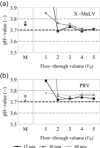Truly continuous low pH viral inactivation for biopharmaceutical process integration
- PMID: 32017010
- PMCID: PMC7187162
- DOI: 10.1002/bit.27292
Truly continuous low pH viral inactivation for biopharmaceutical process integration
Abstract
Continuous virus inactivation (VI) has received little attention in the efforts to realize fully continuous biomanufacturing in the future. Implementation of continuous VI must assure a specific minimum incubation time, typically 60 min. To guarantee the minimum incubation time, we implemented a packed bed continuous viral inactivation reactor (CVIR) with narrow residence time distribution (RTD) for low pH incubation. We show that the RTD does not broaden significantly over a wide range of linear flow velocities-which highlights the flexibility and robustness of the design. Prolonged exposure to acidic pH has no impact on bed stability, assuring constant RTD throughout long term operation. The suitability of the packed bed CVIR for low pH inactivation is shown with two industry-standard model viruses, that is xenotropic murine leukemia virus and pseudorabies virus. Controls at neutral pH showed no system-induced VI. At low pH, significant VI is observed, even after only 15 min. Based on the low pH inactivation kinetics, the continuous process is equivalent to traditional batch operation. This study establishes a concept for continuous low pH inactivation and, together with previous reports, highlights the versatility of the packed bed reactor for continuous VI, regardless of the inactivation method.
Keywords: continuous processing; low pH viral inactivation; residence time distribution; virus clearance; virus inactivation.
© 2020 The Authors. Biotechnology and Bioengineering Published by Wiley Periodicals, Inc.
Conflict of interest statement
The authors declare that there are no conflict of interests.
Figures







Similar articles
-
Continuous Solvent/Detergent Virus Inactivation Using a Packed-Bed Reactor.Biotechnol J. 2019 Aug;14(8):e1800646. doi: 10.1002/biot.201800646. Epub 2019 Apr 23. Biotechnol J. 2019. PMID: 30810288
-
Virus study for continuous low pH viral inactivation inside a coiled flow inverter.Biotechnol Bioeng. 2019 Apr;116(4):857-869. doi: 10.1002/bit.26872. Epub 2018 Dec 31. Biotechnol Bioeng. 2019. PMID: 30450694
-
Continuous low pH viral inactivation: Operation and scaling strategy informs viral clearance study.Biotechnol Bioeng. 2022 Aug;119(8):2115-2121. doi: 10.1002/bit.28117. Epub 2022 Jun 20. Biotechnol Bioeng. 2022. PMID: 35470424
-
Viral Inactivation: Low pH and Detergent.PDA J Pharm Sci Technol. 2015 Jan-Feb;69(1):163-72. doi: 10.5731/pdajpst.2015.01040. PDA J Pharm Sci Technol. 2015. PMID: 25691724 Review. No abstract available.
-
Enablers of continuous processing of biotherapeutic products.Trends Biotechnol. 2022 Jul;40(7):804-815. doi: 10.1016/j.tibtech.2021.12.003. Epub 2022 Jan 13. Trends Biotechnol. 2022. PMID: 35034769 Review.
Cited by
-
Recent Advances and Future Directions in Downstream Processing of Therapeutic Antibodies.Int J Mol Sci. 2022 Aug 4;23(15):8663. doi: 10.3390/ijms23158663. Int J Mol Sci. 2022. PMID: 35955796 Free PMC article. Review.
-
A common framework for integrated and continuous biomanufacturing.Biotechnol Bioeng. 2021 Apr;118(4):1721-1735. doi: 10.1002/bit.27690. Epub 2021 Mar 1. Biotechnol Bioeng. 2021. PMID: 33491769 Free PMC article. Review.
-
Bioprocessing and the Production of Antiviral Biologics in the Prevention and Treatment of Viral Infectious Disease.Vaccines (Basel). 2023 May 17;11(5):992. doi: 10.3390/vaccines11050992. Vaccines (Basel). 2023. PMID: 37243096 Free PMC article. Review.
-
Developments and opportunities in continuous biopharmaceutical manufacturing.MAbs. 2021 Jan-Dec;13(1):1903664. doi: 10.1080/19420862.2021.1903664. MAbs. 2021. PMID: 33843449 Free PMC article. Review.
-
Tethered Bilayer Lipid Membrane Platform for Screening Triton X-100 Detergent Replacements by Electrochemical Impedance Spectroscopy.Nanomaterials (Basel). 2023 Feb 26;13(5):874. doi: 10.3390/nano13050874. Nanomaterials (Basel). 2023. PMID: 36903751 Free PMC article.
References
-
- Albeladi, H. K. , Al‐Romaizan, A. N. , & Hussein, M. A. (2017). Role of cross‐linking process on the performance of PMMA. International Journal of Biosensors & Bioelectronics, 3(3), 279–284. 10.15406/ijbsbe.2017.03.00065 - DOI
-
- Ali, U. , Bt. Abd Karim, K. J. , & Buang, N. A. (2015). A review of the properties and applications of poly (methyl methacrylate) (PMMA). Polymer Reviews, 55(4), 678–705. 10.1080/15583724.2015.1031377 - DOI
-
- Andersson Trojer, M. , Wendel, A. , Holmberg, K. , & Nydén, M. (2012). The effect of pH on charge, swelling and desorption of the dispersant poly(methacrylic acid) from poly(methyl methacrylate) microcapsules. Journal of Colloid and Interface Science, 375(1), 213–215. 10.1016/J.JCIS.2012.02.026 - DOI - PubMed
Publication types
MeSH terms
Substances
Grants and funding
LinkOut - more resources
Full Text Sources
Other Literature Sources

